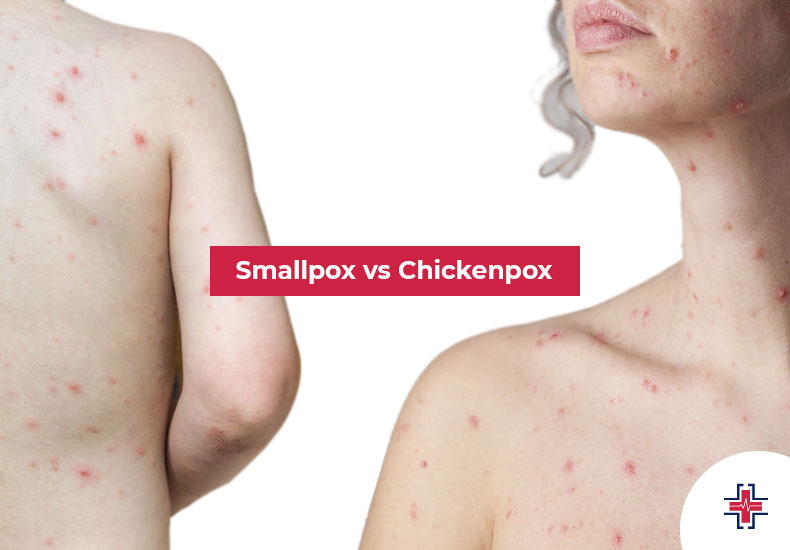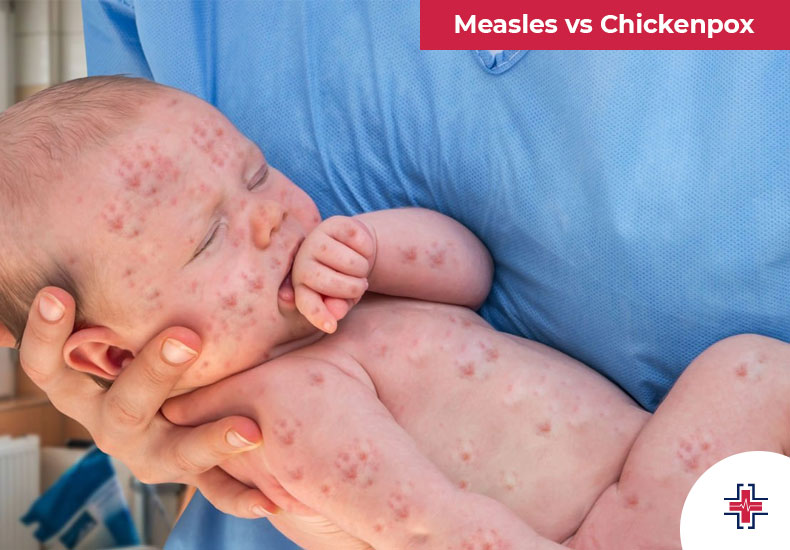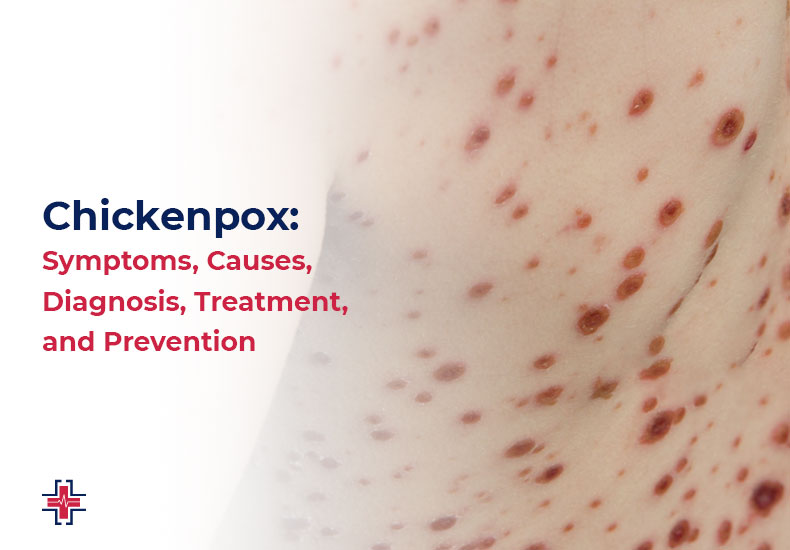The rash begins as little red dots and develops into itchy blisters packed with fluid. upward-pointing right arrow These blisters usually heal in a week or two and finally form a scab.
Being extremely contagious, chickenpox can spread fast from an infected individual to those who have not contracted the illness or received the vaccination.
Although it typically affects children, individuals who have never had the illness or the vaccine are nevertheless susceptible to contracting chickenpox. Adults and adolescents are more susceptible to problems from chickenpox.
Almost everyone contracted chickenpox before becoming an adult in the United States before immunization became commonplace. Hospitalizations attributable to chickenpox have significantly decreased since then. upward-pointing right arrow.
What is Chickenpox?
Chickenpox, commonly known as varicella-zoster, causes a red rash that blisters and scabs. It is very contagious and spreads by physical contact and bodily secretions. With a vaccination, chickenpox can be avoided.
Vaccination is the best way to avoid chickenpox. The effectiveness of the chickenpox vaccination to prevent the disease is actually approximately 94% when two doses are administered.
Even if you’ve received vaccinations, you may still contract chickenpox, though this is rare and the illness is typically milder.
Continue reading to find out more about chickenpox.
Chickenpox Symptoms and Signs
Chickenpox is mostly diagnosed by a rash that develops into painful, fluid-filled blisters. upward-pointing right arrow Before spreading throughout the entire body, this rash may begin on the face, back, or chest.

Blisters from chickenpox usually crust and become scabs within a week or so. Other typical signs and symptoms of chickenpox include:
- Fever
- Headache
- Decreased Hunger
- Fatigue
These signs and symptoms could appear one or two days before the rash does. It is advisable to stay at home and prevent the spread of chickenpox if you have these symptoms and are aware that you have been exposed to the virus.
Causes of Chickenpox
The varicella-zoster virus is the cause of chickenpox. There are two ways the illness spreads:
- Through inhaling virus-carrying air droplets (from a chickenpox patient who coughs or sneezes).
- Through coming into proximity to a chickenpox rash.
Only if you have never had chickenpox or had not had the vaccination puts you at high risk for contracting the illness in these circumstances. Immunity is typically acquired by vaccination or sickness.
The majority of cases of chickenpox are contracted by intimate contact with an infected person. Chickenpox can spread from one to two days before the rash appears until all of the blisters have crusted over or become scabs. You are deemed contagious until no new lesions appear for 24 hours if the lesions do not scab over.
In addition, shingles (herpes zoster) is a viral infection that can be contracted by a person who has chickenpox. Shingles arise when the dormant (inactive) chickenpox virus reactivates in later life, producing a blistering rash that can be excruciatingly painful.
Risk Factors for Chickenpox
Although significant side effects from chickenpox are uncommon in healthy individuals, the illness can result in more serious secondary infections, swelling or infection of the brain, or even death.
Chickenpox consequences are most common in infants, adolescents, adults, pregnant women, and those with impaired immune systems from drugs or sickness.
Adult Chickenpox
Although adults and older children can also contract chickenpox, small children account for the majority of cases.
Adults are more prone to have more severe cases and consequences when they contract chickenpox.
Your risk of developing chickenpox increases if you:
- Not previously had the virus
- Not had a vaccination for it
- Employment in a childcare or educational setting
- Cohabit with kids
How is Chickenpox Diagnosed?
The chickenpox rash is typically sufficient for a medical professional to make the diagnosis. Your physician may order laboratory testing, such as blood tests or culture of lesion samples, if there is any uncertainty regarding the cause of your rash.

Prognosis of Chickenpox
In children in good health, chickenpox is usually mild. Additionally, nearly every serious ailment linked to the disease is avoided by receiving the chickenpox vaccine. After vaccination, chickenpox is usually a mild infection that only affects you or your child.
Duration of Chickenpox
After being exposed to the chickenpox virus, symptoms such as a rash usually appear 10 to 21 days later. The typical duration of the itchy rash caused by chickenpox is five to ten days. Usually, it takes a week or so for every blister to scab over.
Although the majority of chickenpox patients’ symptoms go away in a week or two, the virus remains in the body for the duration of the illness. Generally speaking, the virus doesn’t do anything.
Chickenpox Treatment
The majority of mild cases of chickenpox can be treated with rest, staying at home, and using over-the-counter or homemade medicines to reduce itching and discomfort.
Antiviral medications may be provided to adults and children who are susceptible to problems to lessen the intensity and duration of chickenpox symptoms.

Aspirin should never be administered to kids or teenagers who have chickenpox. By doing this, you run the chance of getting Reye’s syndrome, a dangerous condition that enlarges the liver and brain. Additionally, since some studies have connected nonsteroidal anti-inflammatory drug use to tissue damage or skin infections, consult your doctor before giving an adolescent or child who has chickenpox these medications, such as ibuprofen (Advil, Motrin).
Medication Options for Chickenpox
For the most part, chickenpox can be treated without medicine. See your doctor about using an antihistamine to assist in managing excessive itching if you or your child is experiencing it.
Acetaminophen, or Tylenol, can help reduce fever caused by chickenpox if it affects you or your kid.
Acyclovir (Zovirax, Sitavig) is one of the antiviral medications that doctors frequently administer to patients who have a higher risk of complications from chickenpox.
Some individuals may find that valacyclovir (Valtrex) and famciclovir (Famvir) are suitable alternative antiviral medications.
In certain situations, your physician could advise receiving the chickenpox vaccination three to five days following viral exposure to either avoid or lessen the illness’s severity.
Complementary and Alternative Therapies of Chickenpox
The majority of people just require pain relief and preventative steps to help avoid bacterial skin infections to recover from chickenpox. There are a few tried-and-true DIY solutions:
- Calamine lotion, applied on areas of irritation
- Oatmeal baths or baking soda baths
The itching from chickenpox may be reduced by taking a chilly bath with baking soda, aluminum acetate, uncooked oatmeal, or a colloidal oatmeal solution added.
Another method for relieving itching is a wet compress, which involves soaking a towel in cold water, covering it with an ice pack if preferred, and pressing it up against the skin.
Prevention of Chickenpox
The most effective method of preventing chickenpox is to receive the vaccination. It is advised for those who have never had chickenpox to have this vaccination.
For the chickenpox vaccine to provide adequate protection, two doses are required. The majority of vaccine recipients never get chickenpox, but those who do typically only experience extremely little symptoms like red spots without blisters and low to no fever.
Stay away from people who are known to have chickenpox if you haven’t had the illness or the vaccination. If you think you could have come into contact with someone who has chickenpox in this circumstance, consult your physician.
Complications of Chickenpox
In healthy individuals, complications from chickenpox are rare and vary from minor secondary skin infections to potentially fatal brain enlargement.
Among the potential side effects of chickenpox are:
- Bacterial illness, which typically affects children’s skin and soft tissues
- Infection of the lung, pneumonia
- Infection or enlargement of the brain (encephalitis or cerebellar ataxia)
- Lack of water
- Bleeding issues
- Bloodstream infections in sepsis
- Demise
Infants, teenagers, adults, pregnant women, and those with weakened immune systems from disease or medication—such as those with cancer, HIV/AIDS, or transplant recipients—as well as those undergoing chemotherapy, immunosuppressive drugs, or long-term steroid use—are the groups most at risk of experiencing severe side effects. However, chickenpox problems can arise in even the healthiest youngsters.
Certain complications of chickenpox can be prevented, such as preventing skin infections by not picking at blisters; however, other complications are more difficult to prevent.
Seeing a doctor for a diagnosis and treatment recommendations if you or your child exhibits signs of chickenpox is the best approach to prevent complications from the illness.
Early-life chickenpox in pregnancy can result in some issues for the unborn child, such as:
- Low birth weight
- Anomalies of the legs
In these situations, the baby won’t have chickenpox at birth. However, a woman may contract a serious, potentially fatal illness if she contracts chickenpox soon before or after giving birth.
Statistics: What is the Prevalence of Chickenpox?
- At the age of fifteen, almost 90% of children had contracted chickenpox before the introduction of the vaccine in 1995.
- About 4 million cases of chickenpox were reported in the US annually in the early 1990s, with 100–150 fatalities.
- Hospitalizations and fatalities from chickenpox have decreased by more than 90% since the vaccine was released.
- The Centers for Disease Control and Prevention (CDC) predict that around 98% of individuals who receive both recommended doses of the chickenpox vaccine will receive complete protection, even if the vaccination does not prevent every case of the disease.
Monkeypox vs Chickenpox
It never hurts to review the definitions of chickenpox and monkeypox, even if you undoubtedly know what they are by now.

The Centers for Disease Control and Prevention (CDC) states that monkeypox is a viral illness that can travel between humans and some animals. According to the CDC, the virus that causes monkeypox and smallpox, variola virus, and monkeypox virus, are related viruses. Smallpox and monkeypox symptoms are comparable, although the former is usually less severe and the latter is rarely lethal. According to the CDC, these symptoms can include:
- Headache
- Back pain and muscle aches
- Enlarged lymph nodes
- Feels Cold Tired
- A sore throat
- Congestion in the nose
- Cough
- Rashes on the hands, feet, chest, face, or mouth are possible locations for this rash, in addition to the genitalia or anus. The rash could hurt or irritate.
Notably, the CDC states that monkeypox and chickenpox are unrelated.
According to the CDC, the varicella-zoster virus (VZV) is an extremely contagious cause of chickenpox. It can result in a rash that is itchy and blister-like, commonly starting on the face, back, and chest and then extending to the entire body.
The CDC reports that since the chickenpox vaccine became available in the country in 1995, more than 3.5 million cases of the virus have been avoided. Before then, the disease was extremely frequent in the country.
Smallpox vs Chickenpox
Despite having the word “pox” in their titles, smallpox and chickenpox are very different illnesses.
Even with a vaccine available, children still frequently contract chickenpox these days. The World Health Assembly declared smallpox to be extinct in 1980. A high temperature and a potentially lifelong skin rash were observed by smallpox patients. While the majority would recover, over 30% of cases ended in death.

The first two to three days after the rash appears are when smallpox and chickenpox overlap. Early on, it may be nearly hard for non-medical staff to differentiate between the signs and symptoms.
About 4 million cases of the chickenpox virus occurred annually before the vaccine. Hospitalization was the outcome in thousands of cases. Hospitalizations and cases have declined since then.
A blister-like rash is developed by chickenpox patients, just like in smallpox cases. Before spreading to the rest of the body, this itchy rash will initially occur on the face, back, and chest. The smallpox rash usually takes longer to appear than the chickenpox rash. Usually, it is on the body’s trunk rather than the palms or soles.
Smallpox-related rashes might begin in the mouth or on the face and gradually spread throughout the body. The pustules boil and scab over, and they can be rather painful. The smallpox rash leaves pocks on the palms and soles, which spread more widely to the extremities.
Measles vs Chickenpox
Because the symptoms of chickenpox and measles are similar, individuals often mix the two illnesses. Although neither of these conditions is dangerous, if they are not treated promptly, they may develop major side effects.

Both chickenpox and measles are more likely to spread during the fall and winter. It is quite easy for the epidemic to start at this time. These two illnesses are more common in those with weakened immune systems. Many people mistake chickenpox for measles.
FAQs
Can You Get Shingles If You Never Had Chickenpox
Although you cannot contract shingles if you have never had chickenpox, it is crucial to understand the dangers involved in the illness. The varicella-zoster virus, or VZV, is the same virus that causes chickenpox and shingles. The shingles virus is the cause of chickenpox. This is a communicative rash that primarily affects youth.
Can You Get Monkeypox If You Had Chickenpox
There is a connection between the MPX virus and the smallpox virus. While the two have comparable symptoms, MPX symptoms are less severe than smallpox symptoms. Chickenpox has nothing to do with MPX. Being vaccinated against MPX does not confer natural immunity to chickenpox.
Do Chickenpox Scars Heal?
Throughout the body. The illness typically lasts three to four weeks. The chickenpox lesions will dry up and cure on their own, leaving no scars behind.
Drug Against Chickenpox?
Acyclovir (Sitavig, Zovirax) is an antiviral medicine that your doctor may prescribe if you already have symptoms or are at risk of developing severe chickenpox. It may assist in lessening the severity of your symptoms. The first dose must be taken within 24 hours of the rash appearing.
Chickenpox Vaccine Age?
For toddlers, adolescents, and adults to be protected against varicella, the CDC advises receiving two doses of the varicella vaccine (chickenpox). It is customary to advise children to receive their first dosage between the ages of 12 and 15 months and their second dose between the ages of 4 and 6 years.
A Message from the ER of Mesquite
Before the development of a vaccine in 1995, the chickenpox virus caused thousands of hospital admissions as well as fatalities annually. Over 90% of children are protected from the once-common chickenpox disease by vaccination. Even as an adult, you can still contract chickenpox if you don’t have the vaccination. If you have never had chickenpox, discuss being vaccinated with your healthcare provider or contact ER of Mesquite. Even though the majority of instances are not dangerous, getting vaccinated can lower your chance of contracting the virus. The chickenpox vaccination is given to most kids as part of their childhood immunization schedule.
